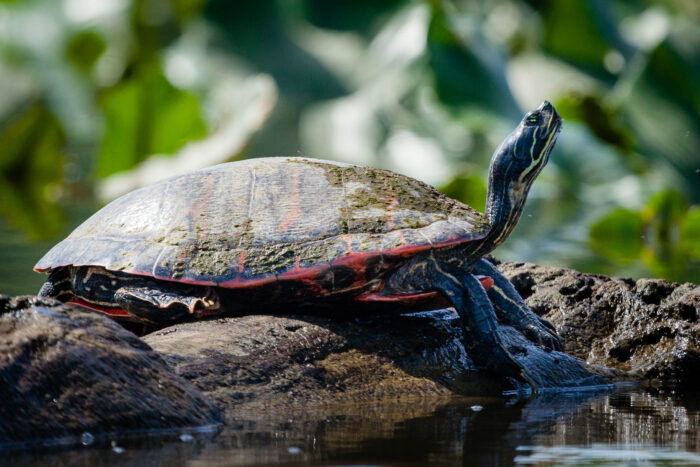Red-bellied Cooter
Pseudemys rubriventris
The red-bellied cooter is an aquatic turtle with a dark, highly domed shell and a distinctive red belly. It can be found basking along the edge of ponds, streams and rivers throughout the Potomac River and in coastal portions of Maryland and Virginia.
This section shows one large critter image at a time. Use the thumbnails that follow to select a specific image to display here.

This gallery contains a grid of small thumbnails. Selecting a thumbnail will change the main image in the preceding section.
Appearance
The red-bellied cooter has a highly domed carapace (shell) that varies in color from brownish to black. Reddish bands appear across the middle of the scutes (plates) on the carapace. These bands vary depending on the turtle’s age and sex, and may only be visible when the shell is wet.
The plastron, or underside of the shell, is a reddish color. Young have a greenish carapace and an orange plastron. Its black head has light lines that run toward the snout, and its heavy upper jaw has a notch in the center.
Feeding
The red-bellied cooter is an omnivore that feeds on snails, plants, worms, tadpoles, crayfish and insect larvae.
Predators
Skunks, crows, raccoons, herons and bullfrogs all prey upon red-bellied cooters. Lawn mowers often kill turtles that are resting in the grass in backyards.
Reproduction and life cycle
Little is known about red-bellied cooter's mating habits. In June or July, females dig a nest near the water. They try to use the same nesting area every year.
Females lay 10 to 20 eggs, covering the nest afterward. They provide no care for their eggs or young. Eggs hatch in 10 to 16 weeks. These turtles live an average of 40 to 55 years.
Did you know?
- Red-bellied cooters are also called the redbelly turtle. They get their name from their reddish plastron, the underside of their shell.
- They are usually found in areas with deep, fast-moving water, a muddy bottom and lots of aquatic vegetation. Red-bellied cooters will sun themselves on rocks and logs to control body temperature, but will disappear into the water when alarmed. In winter, this turtle hibernates in the mud at the bottom of rivers.
- The red-bellied cooter is the largest recorded basking turtle in the Chesapeake Bay region.
- These turtles are extremely shy and easily scared. If you spot a red-bellied cooter in the wild, it’s best to keep your distance and use binoculars to get a better look. If you get too close, it will quickly swim away.
- They can be confused with painted turtles. You can distinguish a red-bellied cooter by its larger size, reddish plastron and lack of yellow marks on its head.
Sources and additional information
- Life in the Chesapeake Bay by Alice Jane Lippson and Robert L. Lippson
- Chesapeake Bay: Nature of the Estuary, A Field Guide by Christopher P. White
- Field Guide to Maryland’s Turtles: Northern Red-bellied Cooter – Maryland Department of Natural Resources
- Northern Red-bellied Cooter – Virginia Department of Wildlife Resources
- Animal Diversity Web: Pseudemys rubriventris – University of Michigan Museum of Zoology
